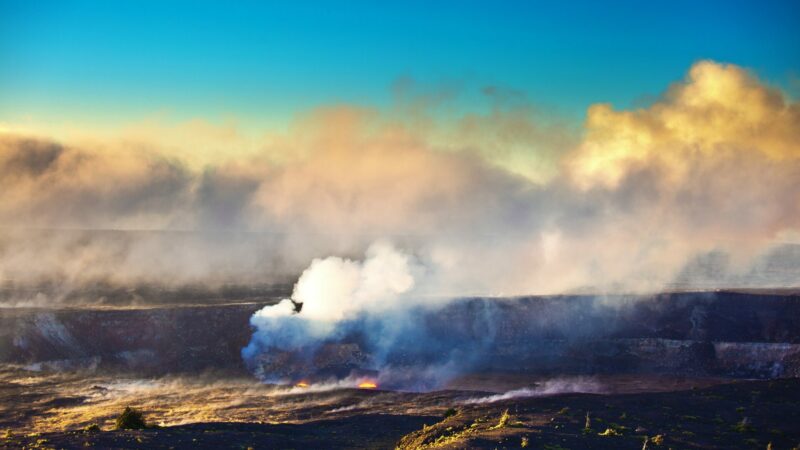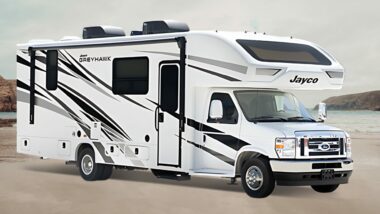Table of Contents Show
If you’re a national park enthusiast wanting to see diversity and unique landscapes, then it’s time to plan a trip to Hawai’i Volcanoes National Park. Stretching from sea level to almost 13,700 feet, this national park captures the beauty and power of the Hawaiian islands. Whether you want to enjoy an auto tour or get out and explore the park on foot, Hawaii Volcanoes National Park is a place unlike any other in the U.S. Let’s learn more!
Pro Tip: If you’re on a volcano tour, be sure to check out Mount Ranier National Park!
Where Is Hawai’i Volcanoes National Park?
One of Hawai’i’s two national parks, Hawai’i Volcanoes National Park is located in the southeastern region of the Big Island. Hawai’i’s second national park, Haleakalā National Park, is on the island of Maui. Hawai’i is also home to one historic trail, one national memorial, two historic sites, and three historical parks.

When Did Hawai’i Volcanoes National Park Become A National Park?
Hawai’i Volcanoes National Park became a national park in 1916. But its original name was Hawai’i National Park. President Woodrow Wilson signed House Resolution 9525 on August 1, 1916, making Hawai’i National Park the 11th national park and the first in a territory. At this point, Hawai’i hadn’t even become a state. On September 22, 1961, Hawai’i National Park was split into Hawaiʻi Volcanoes National Park and Haleakalā National Park.
What’s So Special About Hawai’i Volcanoes National Park?
Home to the largest volcano in the world, Mauna Loa, Hawai’i National Park showcases the power and majesty of volcanic activity. The park is also home to the world’s most active volcano, Kilauea. Visitors and scientists marvel at the unique birth of the Hawaiian Islands and the awe-inspiring landscape.
Additionally, the park not only preserves these mighty volcanoes; Hawai’i Volcanoes National Park also protects a rich cultural heritage and rare ecosystems. In 1980, the park was designated as an International Biosphere Reserve. In 1987, it was named a UNESCO World Heritage Site.
Rangers provide talks on the Hawaiian language, visitors can see traditional homes and pulu factories, and wildlife enthusiasts marvel at the diversity, from endangered sea turtles to the largest dragonfly in the U.S. to the Hawaiian hoary bat. Sadly, many plants and animals are dying because of invasive species. The park protects 23 species of endangered vascular plants, including 15 species of endangered trees.

3 Most Popular Attractions In Hawai’i Volcanoes National Park
Within its 532 square miles, over half of Hawai’i Volcanoes National Park is designated wilderness. In 2022, over 1.5 million people visited this special place. The Kahuku District is a place of rich Hawaiian traditions, including ranching. It’s a fascinating part of the national park that’s worth visiting if you have time. But if you only have a day or two to explore Hawai’i Volcanoes National Park, here are our top three suggestions.
1. Hike the Crater Rim Trail
One of the best hikes is Crater Rim Trail. You can access it from several locations along Crater Rim Drive, including Uēkahuna, Kīlauea Overlook, Steam Vents, and Volcano House. This trail includes the Kūpinaʻi Pali Trail, a walk through history. It leads to a panoramic view of the Kīlauea caldera and the Halemaʻumaʻu crater, which dramatically collapsed in 2018. The steam vents along the Crater Rim Trail are magical and make you feel as though you’ve been transported to another planet.

2. Drive Chain of Craters Road
Second up is Chain of Craters Road, an 18.8-mile drive. You can start at the coast near Holei Sea Arch and drive northeast to the summit of Kīlauea or start at the summit and drive southwest to the coast. Stop at the Puhimau Crater, the Pauahi Crater, the Puʻuhuluhulu cinder cone, the lava flows of Maunaulu, and the largest grouping of petroglyphs in Hawaiʻi. Overlooks and pull-outs make this drive a spectacular way to take in the beauty, history, and power of Hawai’i Volcanoes National Park.
3. Hike To the Nāhuku (Thurston Lava Tube)
Another unique experience at Hawai’i Volcanoes National Park is the hike to the Thurston Lava Tube. This 500-year-old lava tube is home to entire ecosystems. It’s vital that you don’t touch anything. Parking is very limited, so arrive early in the day. It’s a 1.5-mile round-trip hike from the Kīlauea Iki Overlook. Listen to the sounds of native birds as you walk through the lush rainforest before arriving at the lava tube. Beware of the risks when visiting, however. Pay attention to rockfalls, low ceilings, standing water, and tripping hazards.

One way to learn more about the art and culture of the Hawaiian people is to visit the Volcano Art Center. You’ll find paintings, hula performances, tye-dye creations with nature’s oldest dye, and more. This nonprofit educational institution nurtures creative discovery through arts education and artistic development. The Volcano Art Center also promotes the artistic, cultural, and environmental heritage of the native people.
Best Places For Camping Near Hawai’i Volcanoes National Park
If you’re looking for RV camping, you won’t find many options on the Big Island of Hawai’i. However, there are lots of tent camping options outside the national park. You can camp at the state parks along the coast for a short drive to Hawai’i Volcanoes National Park.
Inside the national park, campers can enjoy two drive-in campgrounds at Nāmakanipaio and Kulanaokuaiki. It’s $15/night at Nāmakanipaio. There are restrooms, water, picnic tables, and barbecue pits here. Campers can use the self-pay stations or visit the Volcano House to pay with a credit card.
At Kulanaokuaiki, it’s $10/night and there are tent pads along with picnic tables here, but no water or fire pits. Campers must use the self-pay station. This campground is at a lower elevation (2,700 feet) than Nāmakanipaio, which is at 4,000 feet.

Is Visiting Hawai’i Volcanoes National Park Worth It?
Although a trip to Hawai’i is expensive, we highly recommend planing a trip-of-a-lifetime to this beautiful state. You don’t need but a day or two to visit Hawai’i Volcanoes National Park. Then you can explore even more of the Big Island and head north to Maui to visit Haleakalā National Park. The unique landscape, fragile ecosystems, and rich cultural history make Hawai’i Volcanoes National Park one of the coolest parks we’ve ever seen!






